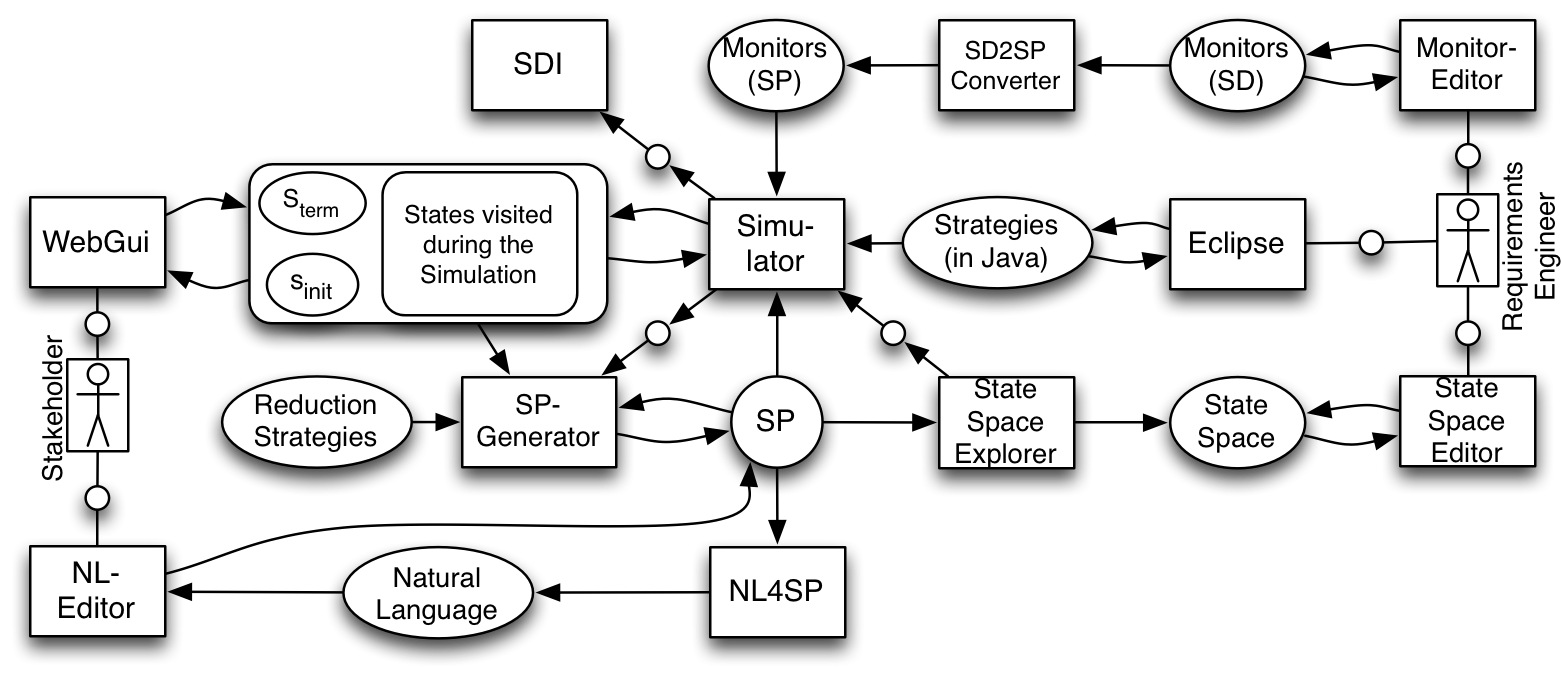The Scenario-Based Tangible Prototyping Environment (SceB-TaPE) project tries to exploit the similarities between formal models and prototypes. By empowering stakeholders to experience the content of formal models just as they would experience a tangible prototype, quick and inexpensive iterations are possible. Using story patterns and executing them to simulate behavior observed in earlier simulation sessions, stakeholders experience what other stakeholders usually do and can complement the corresponding scenarios so that the requirements engineers eventually end up with all valid scenarios of the participating stakeholders.
A complete list of project publications can be found on the page of the research project.
Project overview picture (illustrated using FMC):

Project Team:
- Holger Giese (contact person)
Former Team Members:
Individual Parts of the Software Developed Within the Project:
- The Simulator, which was optimized as part of the Master's Thesis of Stefan Kleff (Efficient Simulation of virtual Prototypes) and which relies on the Story Diagram Interpreter
- Story Pattern Generator which is capable of deriving a story pattern from a pair of states based on their differences
- The Web GUI is an intuitive, interactive workplace visualization which represents the state of a simulation suitable for domain experts
- The State Space Explorer is a tool that can be used to explore the state space which can be created based on the story patterns that were already derived. The explorer and the corresponding State Space Editor were partially developed in the Master's Thesis of Stefan Richter (Strategy-Driven and interactive Simulation of virtual Prototypes)
- A Monitor Editor that allows modelers to define sequences which have to be observed as story diagrams. To be able to execute them within our story pattern simulator, Ralf Teusner also developed a Story-Diagram-to-Story-Pattnern-Converter as part of his Master's Thesis (Smart Simulation of virtual Prototypes)
- The NL4SP Converter was developed in the Master's Thesis of Daniel Eichler (Empowering Stakeholders to Manipulate Formal Models Using Structured Natural Language Representations). It transforms story patterns into an editable Natural Language representation and allows stakeholders to consistently and intuitively modify these story patterns
Software Usage Scenarios:
- The Simulator executes story patterns to simulate behavior observed before from other stakeholders, thereby decoupling the validation of behavioral models in a collaborative multi-user process
- Stakeholders can recognize the side-effects of how they are affected by actions of other stakeholders in the intuitive representation (Web GUI) which is updated each time the context of a participating stakeholder changes
- Thus, stakeholders can interact with each other or simulated roles using affordances offered in the Web GUI
- Behavior observed from participating stakeholders is formally derived and specified in story patterns and, therefore, becomes reproducible
- the simulator may employ strategies to reach distinct goals during the simulation such as maximize profits or to ensure that a specific value stays within a certain limit
- Requirements engineers can create monitors (potentially including side-effects upon violations) that are checked during the simulation to verify specific properties
- Requirements engineers may inspect the state space which is derived from an initial state and the set of already captured story patterns
- Stakeholders may inspect story patterns in their Natural Language representation and can modify them if deemed necessary
Relies upon the Following mdelab.de Software:
- Story Diagram Interpreter (SDI)
- Story Patterns as defined in the Story-Diagram-Ecore (part of the SDI)
Plus these external Tools:
